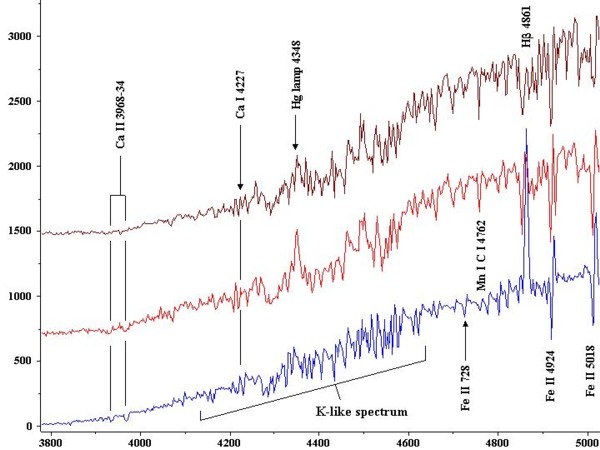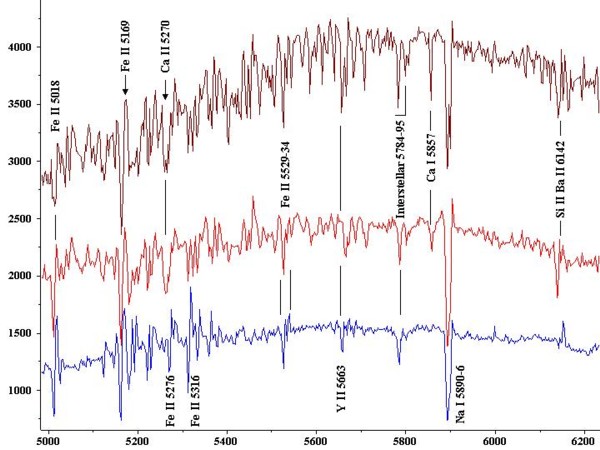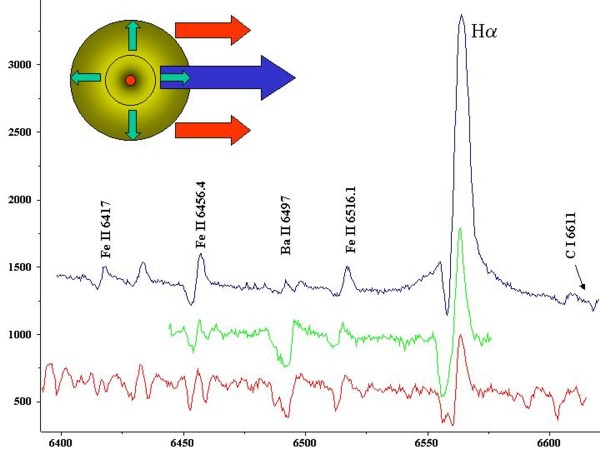THE SPECTRA OF NOVAE AND SUPERNOVAE
Introduction
- V838 Mon(2002)
- V4743 Sgr
- V2363 Cyg
The spectrum of Nova V838 in Monoceros
This nova has been discovered on 6th Jan 2002 by Nicholas J. Brown, Quinns Rocks,
W. Australia, (IAU Circular 7785)when it shined at 10th mag.
The nova position is (equ 2000.0): RA = 7h04m04.85s - DEC = -03░50'50.24".
The spectroscopic history of this object can be found in the IAU circulars 7785, 7786,
7812, 7822, 7829, 7831, 7834, 7855.
Intense emission Ba II lines (6502, 6145, 5859 ┼) are observed on 8 and 9 Jan together
with weaker emissions from Ha and Na I. Fe II, O I (7774 ┼)
and Ca II show in absorption.
On 26th Jan, the spectrum looks like a reddened K giant spectrum with absorbtion of many
neutral metals but without Ba II emissions.
Between the first and the second of February, the spectrum changes and become rich of many
emission lines due to ionized metals like Fe II, Ti II, Cr II, Mg II, Si II.
Our first spectrum, recorded on 7th Feb, also shows all such features.
The expansion speed of the shell surrounding the star, as deduced from the P-cyg line profile
(For explanation on P-Cyg effect goto "Peculiar
B stars " ) is 150 Km/sec on 2 feb but increased to 300 Km/sec on 7 feb.
In the meanwhile, on 3/4 Feb, its brightness increased from 10.5 to about 7,5.
IR spectra recorded on 9-2 and 9-3 showed a blackbody emission corresponding to a temperature of
4500 and 4000 K, as can be expected from the K type visible spectrum.
On 17 February was discovered a light echo reflected from the gases surrounding the nova
and from the expansion angular speed can be calculated the distance of the nova that
results 2300 light years.
Form these first observations the spectral behaviour of V838 Mon looks like that of a slow nova, but
it does not looks like that of a Fe or He/Ne nova.
The spectra reported below were recorded at the Campo dei Fiori observatory on 7, 19 february
and on th 8th of March with a 60 cm F/20 Cassegrain telescope.
After conjunction with the sun, L. Buzzi recorded an image of the expanding echo of light of this nova, reporded in picture 5. On 6th of November (10 months after nova burst) the light echo spanned about 75 arc sec.

|
Picture 1: Spectra of the nova V838 (at a dispersione of 2,6 ┼/pixel) recorded at 19.20 TU on 7th
of february 2002 (blue), at 21.50 TU on 19th february (red) and at 20 TU on 8th March (brown).
It can be noticed the progressive reddening of the spectrum that looks like a K type spectrum (
the Ca II lines are less and less visible with time).
Fe II and hydrogen emission lines are also weakening and show P-Cyg profile. The spectrum
continues into pictures 2 and 3.
|

|
Picture 2: Continued from picture 1. Again, can be observed the reddening of the spectrum
and an increase of Ca absorptions. The deep Na I absorption contains also a contribution
from interstellar clouds.
The spectrum continues in picture 3.
|

|
Picture 3: Continued from picture 2. The number of absorption lines increases in the more
recent spectrum while the H a weakens.
A more detailed view of H a spectral region can be found into
picture 4.
The spectrum can be completed with picture 1 e 2.
|

|
Picture 4: High dispersion spectra (0,42 ┼/pixel) recorded at 18.57 TU on 7th
feb 2002 (blue), at 21.15 TU on 19th feb (green) and at 20.15 TU on 8th March (red),
centered around Ha line.
It can be seen an evolution of the P-Cyg type emission of Fe II and Ha
that shows in early spectra only one shell with expanding speed of 300 Km/sec while in
the last spectrum the absorption is doubled due to two different speeds of expansion at
300 and 150 Km/sec.
|

|
|
Picture 5: The echo of light as it was recorded by Luca Buzzi at the 0.6 m F4.64 telescope at Campo dei Fiori Observatory. Detector was HI-SIS 33 CCD camera and exposure time was 5x60 sec. Limiting mag is about 19.9. The circular echo has expanded up to 70 arc sec in 10 months since the nova burst.
The central star appears to be weak in VIS (about mag 15) but still quite bright in NIR (about mag 12) because of the contribution of the red component and of because of the fading of the blue dwarf and accretion disk.
|
Goto Introduction or to other Novae and Supernovae spectra:
Introduction
- V4743 Sgr
- V2363 Cyg
|
|





